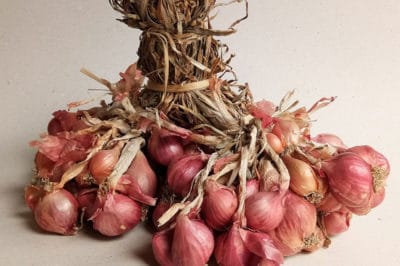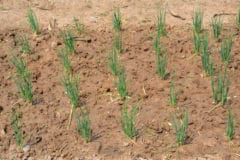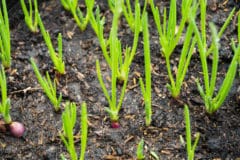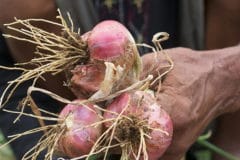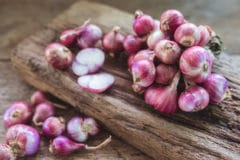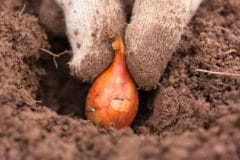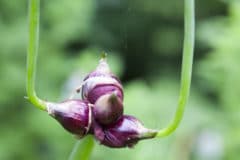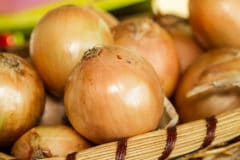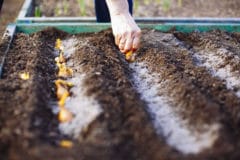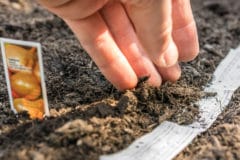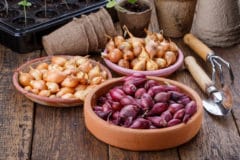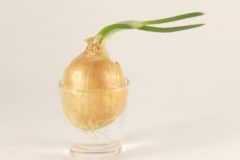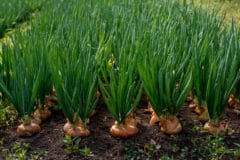Planting Shallot Sets in the Fall
If you want an early spring harvest, you can plant your shallots in October so that they are in the ground before the first hard freeze. Exposing shallots to a hard freeze enhances their flavor and produces larger bulbs.
Work the soil thoroughly, especially if you have a heavy clay soil rather than a light, loamy or sandy soil.
Dig holes that are 6 inches to 8 inches apart in rows that are at least 12 inches apart. The holes should be just a little larger than the set.
Place some compost, well-aged manure, or a balanced organic fertilizer in the hole and cover it with half of the dirt from the hole.
Place the shallot in the hole with the pointed end up and the wider root end, or basal plate, down. Cover the shallot with about 1/2 inch of soil, leaving just a bit of the tip showing. Finally, cover your shallots with 6 inches of leaves.
Shallots form clusters of bulbs rather than single bulbs, so they require more room than garlic or onions. If you crowd your shallots too closely together, you will end up with smaller bulbs and fewer cloves.
Planting Shallot Sets in the Spring
If you intend to plant to sow your shallots in the spring, you should still work the soil thoroughly in the fall and then cover it with leaves. In the spring, plant your shallot sets four to six weeks before the last frost date in your area.
You will need to plant them early enough that they will have 30 days with temperatures that remain between 32°F and 50°F (0°C and 10°C) to encourage sprouting. Just use the same spacing and planting method that’s described under fall planting.
Shallot Varieties to Use as Sets
Some varieties of shallots can be stored for longer periods than others. Some of the varieties that can be stored for longer periods include:
- Bonilla – has a very pungent flavor; harvest in 100 to 105 days; produces four to five 2-inch bulbs by mid-summer; can be stored for planting for the next spring or early summer.
- Olympus – harvest in 90 days; stores well.
- Ambition – harvest in 100 days; best for northern climates; can be stored for planting for the next spring.
- Holland Red – stores well.
- Xtra Select Premium Gold – stores well.
- Mirage – harvest in 92 days; can be stored for planting for the next spring.
- Dutch Red – stores well.
- Picador – harvest in 105 days; similar to Ambition; stores well.
- Pikant – harvest in 80 days; stores well.
- Saffron – harvest in 100 days; stores well.
- Consevor – harvest in 110 days; similar to Ambition, but produces only a single bulb; stores well.
Creating Your Own Shallot Sets
When the leaves of your shallots fall over and begin to turn brown, your shallots are ready to harvest. Don’t simply pull your shallots up out of the ground as you would green onions. In order to store them as long as possible, you need to protect the outer, brown paper-like layer that surrounds them from damage.
Instead of pulling up your shallots, you should carefully dig them up with a shovel, pitchfork, or garden fork. Gently shake the excess dirt from your shallots, but do not rinse or wash them.
You need to dry, or cure, your shallots for one to four weeks in a warm, dry area until that papery skin feels completely dry and crackly. Rinsing and washing your shallots lengthens the drying period and could give mold a chance to grow.
When your shallots are dry, set aside some of the bulbs to use as sets for next planting season. Store the shallots that you want to keep as sets or for eventual culinary use over the long term in mesh bags, nylon hose, or paper lunch bags punched with holes. While the finer mesh of nylon hose may provide more protection from mold spores, using paper bags allows you to label the shallots that you want to use for cooking and the ones that you want to save as sets.
